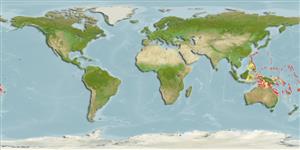Environment: milieu / climate zone / depth range / distribution range
Ecologia
marinhas associadas(os) a recifes; intervalo de profundidade 1 - 37 m (Ref. 86942). Tropical; 28°N - 34°S, 115°E - 174°W (Ref. 5222)
Western Pacific: Ryukyu Islands south to Lord Howe Island and east to Howland Island and Samoa. Often misidentified as Epinephelus macrospilos or Epinephelus corallicola.
Comprimento de primeira maturação / Tamanho / Peso / Idade
Maturity: Lm ?, range 24 - ? cm
Max length : 55.0 cm TL macho/indeterminado; (Ref. 48635)
Espinhos dorsais (total) : 11; Raios dorsais (total) : 15 - 17; Espinhos anais: 3; Raios anais : 8. Distinguished by the following characteristics: head and body pale grey or brownish grey, covered with small brownish black spots with diffuse edges, separated from adjacent spots by spaces equal to or greater than width of the spots; body with black saddle blotch , smaller black saddle blotch on the caudal peduncle; dusky margins of the soft dorsal, caudal and anal fins, with white line along edge; median and pelvic fins with dark spots; dusky pectoral fins with few dark spots basally; body depth contained 2.9-3.3 times in SL; HL 2.2-2.5 times in SL; flat interorbital area, convex dorsal head profile; rounded preopercle, slightly enlarged serrae at angle; maxilla reaches past vertical at rear edge of eye; 2-4 rows of teeth on the midlateral part of lower jaw; pyloric caeca 13 (Ref. 89707).
Usually found over rocky areas or on coral reefs. Feeds on fishes and crustaceans (shrimps and crab) with occasional molluscs or worms (Ref. 89707). Nothing has been published on its biology. Appears to be very rare and therefore of little commercial importance. In Hong Kong live fish markets (Ref. 27253).
Ciclo de vida ou comportamento de acasalamento
Maturidade | Reprodução | Desova | Ovos | Fecundidade | Larvas
Heemstra, P.C. and J.E. Randall, 1993. FAO Species Catalogue. Vol. 16. Groupers of the world (family Serranidae, subfamily Epinephelinae). An annotated and illustrated catalogue of the grouper, rockcod, hind, coral grouper and lyretail species known to date. Rome: FAO. FAO Fish. Synop. 125(16):382 p. (Ref. 5222)
Status na Lista Vermelha da UICN (Ref. 130435: Version 2024-1)
Ameaça para os humanos
Harmless
Uso pelos humanos
Pescarias: pesca de subsistência; Aquário: Aquários públicos
Ferramentas
Relatórios especiais
Baixar XML
Fontes da internet
Estimates based on models
Preferred temperature (Ref.
123201): 24.7 - 28.9, mean 27.5 °C (based on 268 cells).
Índice de diversidade filogenética (Ref.
82804): PD
50 = 0.5000 [Uniqueness, from 0.5 = low to 2.0 = high].
Bayesian length-weight: a=0.01175 (0.00793 - 0.01740), b=3.04 (2.93 - 3.15), in cm total length, based on LWR estimates for this species & Genus-body shape (Ref.
93245).
Nível Trófico (Ref.
69278): 4.0 ±0.64 se; based on food items.
Resiliência (Ref.
120179): médio(a), tempo mínimo de duplicação da população 1,4 - 4,4 anos (Preliminary K or Fecundity.).
Fishing Vulnerability (Ref.
59153): Moderate vulnerability (42 of 100).
Nutrients (Ref.
124155): Calcium = 27.1 [13.3, 57.2] mg/100g; Iron = 0.468 [0.256, 0.969] mg/100g; Protein = 18.6 [17.1, 20.0] %; Omega3 = 0.117 [0.074, 0.184] g/100g; Selenium = 31.2 [18.6, 55.7] μg/100g; VitaminA = 189 [53, 677] μg/100g; Zinc = 1.26 [0.87, 1.77] mg/100g (wet weight);
